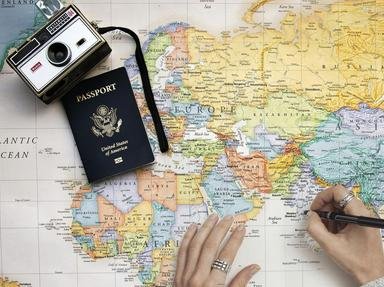Quiz Answer Key and Fun Facts
1. For our first hike along a great nature trail, we will travel far north, over a hundred miles beyond the Arctic Circle. Spanning 275 miles (443 km) across four natural parks and taking you over the shoulder of the country's highest peak, Mount Kebne (Kebnekaise), this trail, called "The King's Trail" - "Kungsleden" in its native language - is situated where?
2. From the chilly north we now travel to the blazing south. The Grand Canyon in Arizona, USA has long been a popular hiking destination, both for short day-trips and for gruelling rim-to-rim expeditions. However, such hikes are not an easy venture and require thorough preparation and constant vigilance during the hike itself. Which of the following are you most likely to encounter during the Grand Canyon hike?
3. Still not cooling down, we now travel south-west to undertake a relatively short (11 miles, or 18 km) but strenuous hike along the Kalalau Trail. Named among the "The Twenty Most Dangerous Hikes" in the world by the "Outdoor Magazine", it runs along the picturesque Na Pali Coast, located where?
4. Having warmed up during a couple of hikes in the south, we are now flying to Lukla, Nepal, the starting point of the famous multi-day trek to the Everest Base Camp. This mountain town in Khumbu area of Nepal lies 9320 feet (2840 m) above the Dudh Kosi, the river that starts high in the Everest massif. Due to the unusual color of its water, its name alludes to what?
5. Deciding to take a break from uphill walking for the moment, we opt for a coastal hike instead. Our next destination is the Queen Charlotte Track in New Zealand which takes us along the northern coast of the South Island, in the area named after a prominent personage in British history who became a duke during the reign of Queen Anne. What is the name of this area?
6. Feeling well-rested after a week on the coast, we are now ready for a challenging mountain route, and we head straight to the famous Yosemite National Park in central California. Open only in high summer, the Yosemite Grand Traverse runs through the drainage of what major river in Yosemite Valley?
7. Keeping our warm clothes handy, we now head north to follow in the footsteps of the gold-seekers of the Klondike Gold Rush of the 1890s. We'll follow the famous Chilkoot Trail from Dyea, Alaska, USA to the lake in British Columbia and Yukon Territory in Canada whose name sounds similar to the last name of the main character in one of Jane Austen's novels. What is the name of this lake?
8. Having had enough of the north for now, we are flying to Patagonia, Argentina, to take the Grand Tour of the Fitz Roy Massif. On the penultimate day of the tour, we come to Paso Del Viento, the lookout to which natural attraction, the third largest of its kind in the world?
9. Having seen some of the highest mountains in the world on this tour, we are now ready to ascend one of them. Determined to reach the top of the Uhuru Peak, the highest point of Mount Kilimanjaro, we are now flying to which African country, the home of this highest free-standing mountain in the world?
10. Our last hike on this tour may well prove to be the most challenging yet, and will require all the skills that we acquired while hiking along great nature trails. This trail takes us to the island of Newfoundland, for the Long Range Traverse of the second largest national park in Atlantic Canada, whose name can be translated from French as "great gloomy". What is the name of this national park?
Source: Author
Reynariki
This quiz was reviewed by FunTrivia editor
Tizzabelle before going online.
Any errors found in FunTrivia content are routinely corrected through our feedback system.

